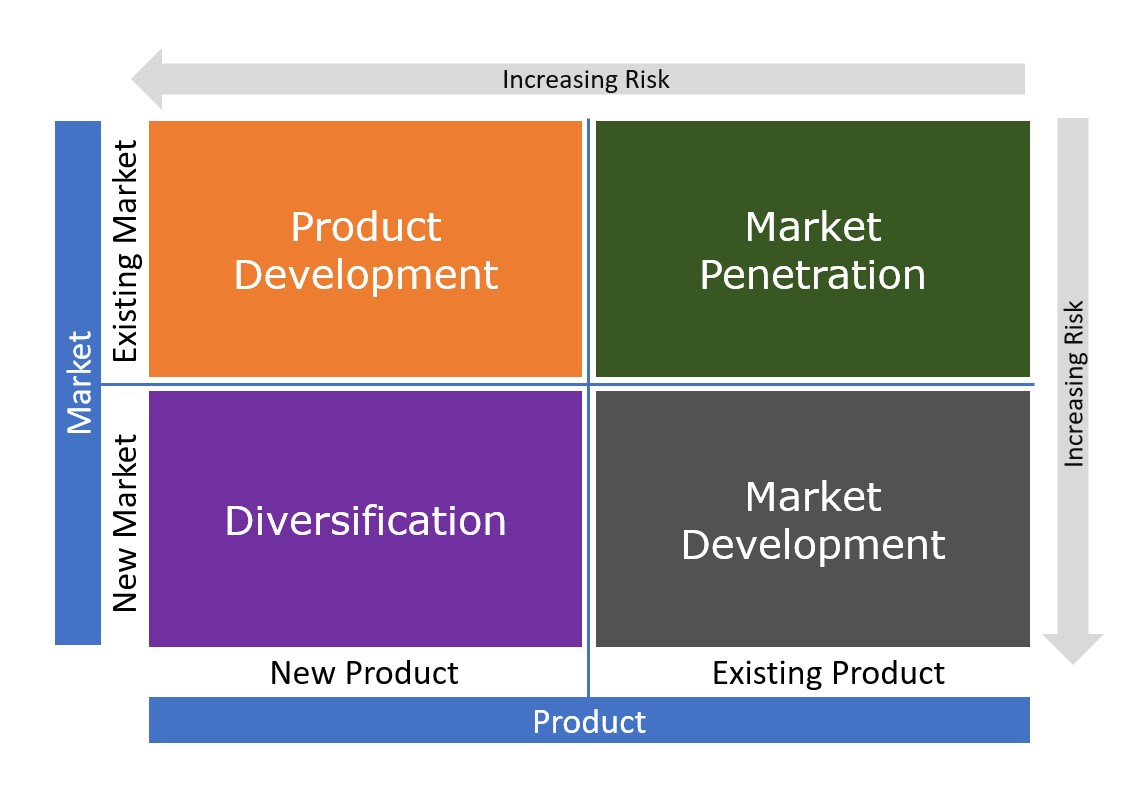What is Ansoff Matrix?
The Ansoff Matrix was developed by the applied mathematician and business manager H. Igor Ansoff. It was published by Harvard Business Review in 1957, it is also known as The Ansoff as the Product/Market Grid.
The Ansoff Matrix is a tool used by organisational leaders to analyze and plan strategies and risks for business growth. The matrix displays four strategies used to help an organisational growth. In addition, it analyzes the risk associated with each strategy.
Ansoff Matrix Four Strategies

1. Market Penetration: it focuses on increasing sales of the existing product in an existing market aiming to increase the market share.
2. Product Development: focuses on introducing new products to an existing market.
3. Market Development: focuses on entering new markets using existing products.
4. Diversification: focus on entering new markets with the introduction of new products.
Following the four strategies of the Ansoff Matrix, market penetration strategy has the lowest risk factor while diversification strategy has the highest risk factor.
Let us have a deeper look on each of the four Ansoff Matrix strategies:
1. Market Penetration
During the market penetration strategy, the organisation focuses on increasing the sales (market share) of its current products in the existing market that it operates in.
There is multiple effective market penetration strategies which might include:
- Revamping and enhancing the current marketing strategy to reach new clients in the current market.
- Introducing and rolling out a product loyalty scheme to the existing customers.
- Increasing direct sales points and presence in end customer’s outlets.
- Introducing special offer promotions to attract existing and new customers leading to revenue increase.
- Utilize the Boston Matrix and AIDA Model.
When organisations use the Marketing Penetration strategy approach, they often seek to achieve the following objectives:
- Maintain and increase the market share of their current products in the market.
- Secure dominance over growing market to lower the chances of competing products from expanding in their existing market.
- Restructure a mature market to drive out current existing competitors.
- Increase product sales and usage by existing customers. e.g. promotions & loyalty programs.
2. Product Development
During the product development strategy, the firm focus on introducing a new product to an existing market. That will involve conducting extensive research and development to achieve the expansion of the products range. The firm need to create a solid understanding of the current market status and needs to be able to produce innovative solutions or products to meet the need of this existing market. This strategy may require to develop modified product which can appeal to the existing markets and their local needs.
Effective product development strategy might include:
- Investing in research and development to develop new solutions or products to the current existing market.
- Creating a detailed understanding to customer’s needs and how those need changes over time.
- Acquisition of competitor’s solution or product.
- Merging the resources with other firm to create a new product that better meets the customer needs in the existing market.
- Developing a strategic partnership with other firms to gain access and benefit from their brand and distribution channels.
3. Market Development
Market Development strategy, is the name given to a growth strategy where an organisation is targeting new market with their existing product, it can also be targeting new segments in the current market. This involve conducting SWOT analysis to identify opportunities and threats.
Effective market presentation strategy might include:
- Diversifying the sales channels; such as online sales, direct sales, etc.
- Expanding to new geographical markets; such as exporting to new countries (expanding globally).
- Entering into new domestic market (expanding regionally).
- Creating market segmentation targeting different segments; demographics, age and gender.
- Developing different pricing policies to attract new customer segments.
4. Diversification
As the names state, diversification is the business strategy which the company created to enter a new market with a new product. The company can achieve this with by commencing or acquiring a business, which is not related to its existing product line and market.
There are two types of diversification an organisation can deploy:
1. Related Diversification: is deployed when there are potential synergies to be realized between the existing business and the new product.
2. Unrelated Diversification: is deployed when there are no potential synergies to be realized between the existing business and the new product/market.
As highlighted earlier, Diversification is the highest risk growth strategy to be adapted as the organization in this scenario is moving into new market which it has little or no experience. In other words, the company gets into business with new product with no experience about the market nor the impact of the product seeking an opportunity to create a competitive position in the new market.
For a business to adopt a diversification strategy, organisations must have a clear forecast of the expected gains from this strategy and a detailed risk assessment. However, a right balance between the risk and rewards can be highly rewarding.

Comments
No Comments added, be the first...